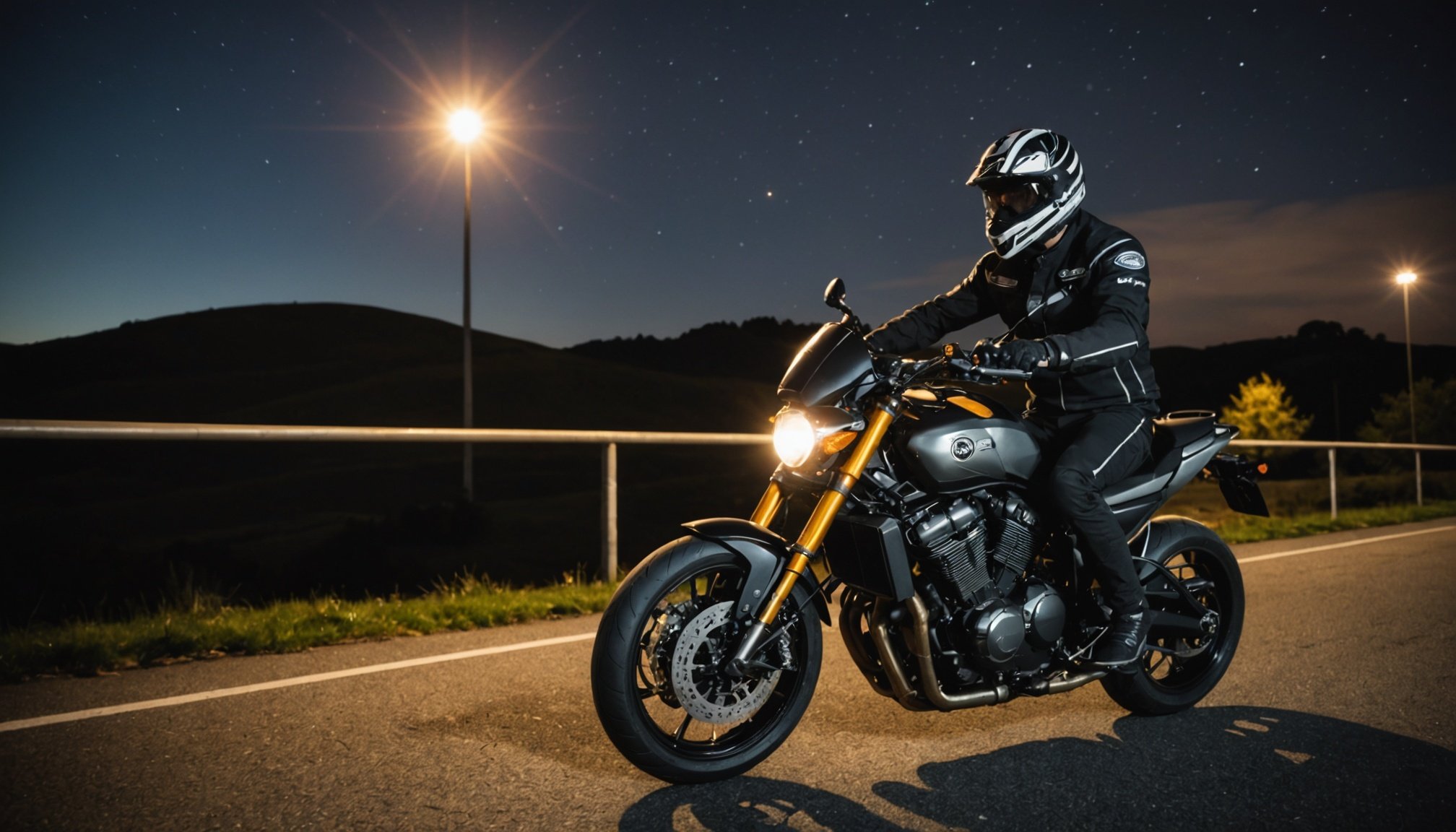Importance of Visibility for Sport Bikers
When riding at night, visibility for sport bikers becomes critically significant due to reduced lighting conditions. Many accidents involving motorcycles occur at night due to poor visibility. In fact, while only a third of all motorcycle rides might happen at night, these rides account for more than half of motorcycle accidents. This is often due to limited sightlines and the inability of other drivers to see bikers approaching.
The impact of visibility is profound on rider safety. Without sufficient illumination and reflective gear, other drivers may not notice bikers in time to avoid collisions. This creates hazardous situations, especially on busy or dimly lit roads. Therefore, it’s vital for sport bikers to enhance their nighttime motorcycle riding safety by adopting high-visibility equipment and techniques.
Also read : Boost your sport bike”s visibility: essential lighting tips for navigating foggy uk conditions
Ensuring better visibility isn’t just about seeing but also about being seen. Reflective clothing and auxiliary lights can significantly reduce the risk of accidents. Riding safely at night means making oneself visible to others while maintaining the ability to see obstacles ahead. By understanding and addressing visibility challenges, sport bikers can considerably boost their safety during nighttime rides.
Essential Gear for Night Riding
For sport bikers, choosing the right motorcycle gear for night riding is essential for safety. Reflective gear for bikers plays a crucial role in enhancing visibility on the road. High-visibility clothing, such as vests with reflective strips and brightly coloured jackets, significantly increase the rider’s chances of being seen by other motorists.
In parallel : Essential tips for optimizing sport bike suspension: enhancing passenger comfort on british roads
High-Visibility Clothing
Selecting the right reflective clothing can mean the difference between visibility and vulnerability. Color contrast is vital—gear with bright or neon colours stands out against the dark night. Reflective materials catch and reflect light from streetlights and vehicle headlights, making bikers more noticeable. Furthermore, layering techniques ensure that riders remain comfortable while maintaining visibility, even as temperatures fluctuate during night rides.
Effective Lighting Solutions
Lighting solutions such as powerful LED headlights are invaluable. These headlights offer enhanced brightness, significantly improving the biker’s field of vision. Auxiliary lights, including LED strips and fog lights, further contribute by illuminating blind spots. Regular maintenance, like cleaning lenses and checking bulb efficiency, guarantees optimal performance. Adjusting position, angle, and brightness as needed ensures that these lighting accessories achieve their intended purpose of safeguarding during nighttime rides.
Techniques for Improving Nighttime Visibility
Mastering night riding techniques is crucial for enhancing visibility and ensuring safety. Position wisely on the road to maximise exposure to headlights, which aids in identifying potential hazards. This strategic positioning also helps other drivers notice you more easily, reducing the risk of accidents.
Relying on road markings and signs can assist in navigation. These guides provide visible cues that help you stay on course and anticipate upcoming turns or intersections, even in low-light conditions. By following these markings, you can maintain your direction with confidence.
Adjusting riding speed and keeping safe distances are essential motorcycle riding tips for the night. Slowing down improves reaction time for unexpected obstacles or sudden changes. Maintaining an appropriate distance from other vehicles helps avoid hurried stops or evasive manoeuvres. This spacing allows enough time to react calmly and safely to any potential danger.
Moreover, incorporating these night riding techniques boosts overall riding proficiency during less visible hours. Riders are encouraged to practice these strategies regularly to build instinct and confidence, turning night rides into safer, more enjoyable experiences. By refining your approach, the night becomes less intimidating, and visibility challenges diminish.
Understanding UK Laws and Regulations for Night Riding
Navigating the intricacies of UK motorcycle laws is crucial for those venturing on nighttime rides. Compliance with these regulations not only enhances safety but also helps avoid penalties. Nighttime riding regulations in the UK mandate specific lighting and reflective gear for bikers, ensuring that they remain visible to other road users.
One critical legal requirement includes equipping your motorcycle with functioning front and rear lights. These lights must be switched on from sunset to sunrise, ensuring continuous illumination. Additionally, the use of reflective elements on your bike or clothing is highly encouraged to further boost visibility. Failure to comply with these stipulations can result in fines or penalty points on your licence.
For motorcyclists, incorporating reflective gear such as vests and helmets equipped with reflective strips is advisable. This gear significantly boosts visibility, making it easier for motorists to notice and avoid collisions.
Adhering to UK motorcycle laws is not just about legal compliance; it’s also about fostering a safe riding environment. These regulations are designed to protect all road users and promote awareness during the more challenging hours of the day.
Personal Experiences and Testimonials from Sport Bikers
Experiences from seasoned bikers offer a wealth of practical insights into improving visibility for sport bikers during night rides. Many riders have shared firsthand accounts highlighting the challenges encountered when nighttime motorcycle riding safety is compromised. These stories often underscore the critical need for vigilance, proper gear, and proactive techniques to navigate poorly lit roads.
One avid biker recounted a near miss due to limited visibility at a dark junction, emphasizing the role of strategic road positioning and regular gear checks. His experience underlines the importance of accurate predictions: staying in well-lit areas and ensuring lights and reflectors are functioning can significantly alter outcomes.
Another testimonial elaborates on the transformative effect of reflective gear. A biker noted how adding extra reflective strips to the helmet and jacket not only boosted confidence but visibly reduced close encounters with other vehicles.
A collective takeaway from these experiences is the encouragement to engage with the riding community. Sharing tips and evolving visibility practices based on real-world scenarios create a shared learning culture that empowers bikers to tackle night rides with enhanced safety awareness and camaraderie.











